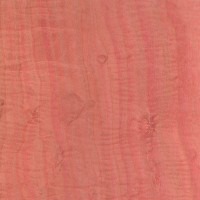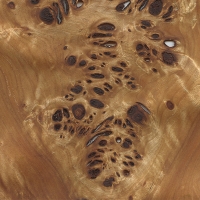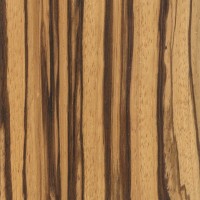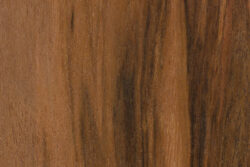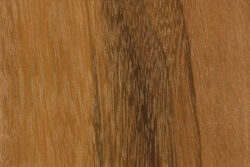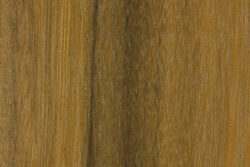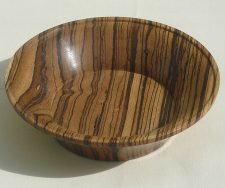
by Eric Meier
In my experience, the three characteristics that contribute to a wood’s subjective level of beauty are color, grain figure, and what I will call contrast (i.e., streaked woods, the subject of this article).
Let’s take a look at each of these briefly and see why I view a wood’s contrast as the best bet for wood projects where budget (with some exceptions) and also timelessness is considered.
Color: These are woods that have their claim to fame more or less solely based on their color. Take away their color, and you take away their appeal. In this group are woods like bloodwood, purpleheart, pink ivory, and ebony. But the problem with a lot of these woods is that their color may not stand the test of time. While exceptions exist, in my personal experience, if you’re looking to create a wood project that will become a family heirloom, you need to look to the next categories.
Grain Figure: These are woods where the growth patterns of the tree create irregularities in the wood, and can create some truly stunning and three-dimensional looking patterns on (or in?) the wood. Woods in this categories would include all burls (like the uber-expensive amboyna), things like birdseye or curly maple, as well as ray flecking in quartersawn woods like lacewood or leopardwood. For the most part, these woods are great picks, but with nicely figured woods like quilted maple, they can reach staggering prices as you are more or less competing with fanatical electric guitar makers and other very motivated artisans for a limited supply. Also, grain figure can sometimes limit the size of lumber, and/or make it unsuitable for structural purposes, such as in the case with burl wood.
Contrast: Contrary to popular belief, and in distinction from the grain figure category above, nearly all of the woods in this category don’t derive their color contrast from the grain itself. For instance, zebrawood’s stripes don’t coincide precisely with any annual growth rings. The two are independent factors. (This is also not to be confused with commercial wood stains: for instance, staining red oak to highlight the growth rings. Technically, pigments are being lodged in the larger earlywood pores of the grain, creating the faux-contrast of the stain.) While prices for these streaked and striped woods can vary a lot (admittedly they do tend to fall a bit on the pricier side), they are usually available in larger sizes, and their patterns are much less subtle and elicit a “wow” from across the room—which is not always the case with some of the more intricate patterns seen in figured grain like curl or quilt.
The Types of Woods with Good Color Contrast (I.e., the streaked, striped, and veined woods of the world)
With our previous introduction out of the way, let’s take a look at the major categories of these woods, with the overall appearance and the strengths and weaknesses of each type.
Streaked Hardwood Flooring
All of these woods can be found in rather large sizes, and are used for flooring and decking. They tend to be difficult to work, but have very good durability ratings.
The figure on these woods could best be described as intermittent streaks. They may not have the most consistent streaks, or the sharpest contrast within the streaks, but they are very much known for their figure.
When compared to most the of the other woods on this list, prices for these woods tend to be low for an imported hardwood.
Pros:
- Relatively inexpensive for imported hardwood
- Available in larger sizes
Cons:
- Can be difficult to machine, glue, and finish
- Streaks can be hit-or-miss
Striped Hardwood Lumber
Zebrawood
Marblewood
Beli
Fancy (Expensive) Rosewood
Brazilian rosewood
Madagascar rosewood
Ziricote
Striped Ebonies (also Expensive)
Macassar ebony
Various striped ebonies (usually from Asia)
Color-Variegated Hardwoods
Spalted Woods
Spalted maple
Sometimes other domestic species are available, as well as imported woods like spalted tamarind.
Discolored or Fungal-Induced Patterns
Very similar to spalted woods, though not causing the tight, inky lines that are sought after in spalted woods.
Ambrosia maple
Tiger myrtle
Pecky cypress
Flame box elder
Old Growth Softwoods
Perhaps the most overlooked or under-appreciated category today.
Southern Yellow Pine (aka antique heart pine)
Douglas Fir
Partridgewood & Co.
Remember how I said at the start of the article that nearly all of the woods in this category don’t derive their color contrast from the grain itself? Well, this would be one of those exceptions. But it’s not really from the area that you’d expect. Ordinarily, “growth rings” are formed from larger earlywood pores forming in rows, thus creating contrast. But here, it is actually lighter-colored bands of parenchyma cells that give these woods their unique striped appearance.
Exceptional Outliers
Snakewood!
Technically, the patterns on snakewood are not caused by anything relating to the grain. Snakewood is more or less in a class of its own. However, the intricate details seen in snakewood tend to have more in common with figured grain rather than the more macro-focused

